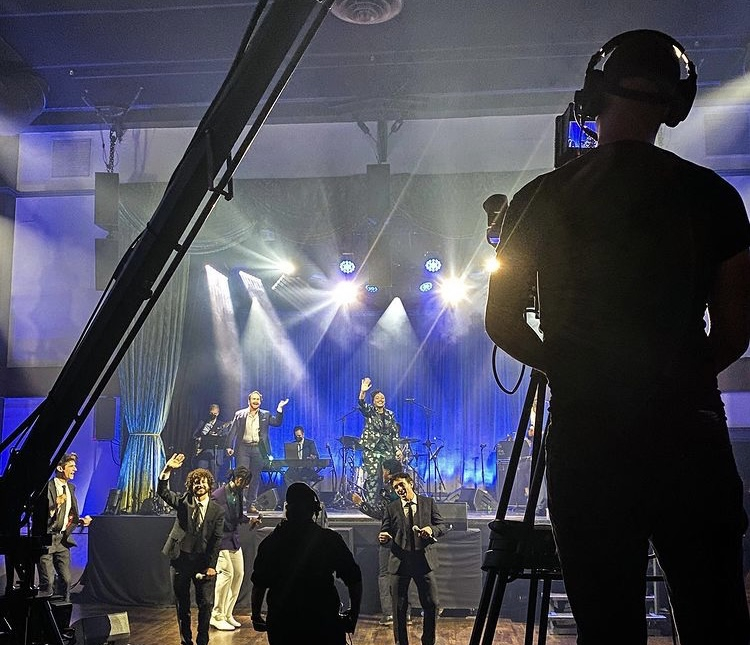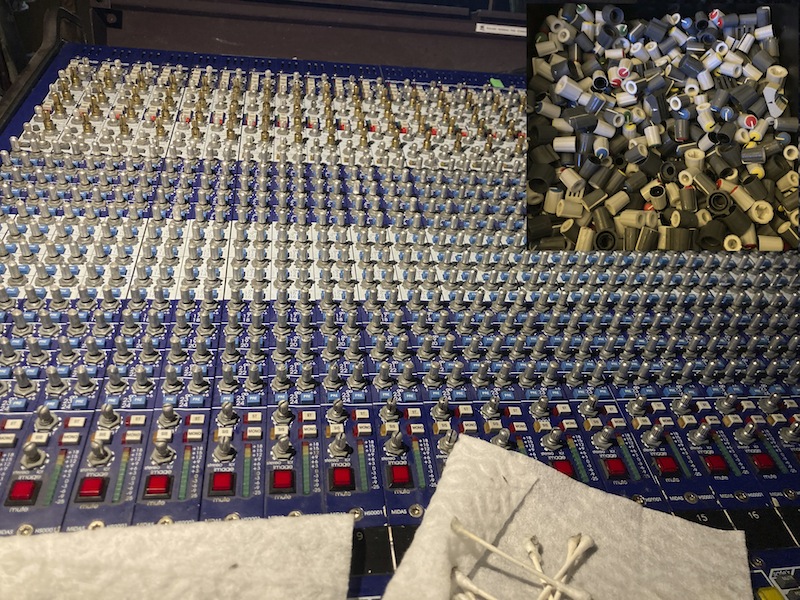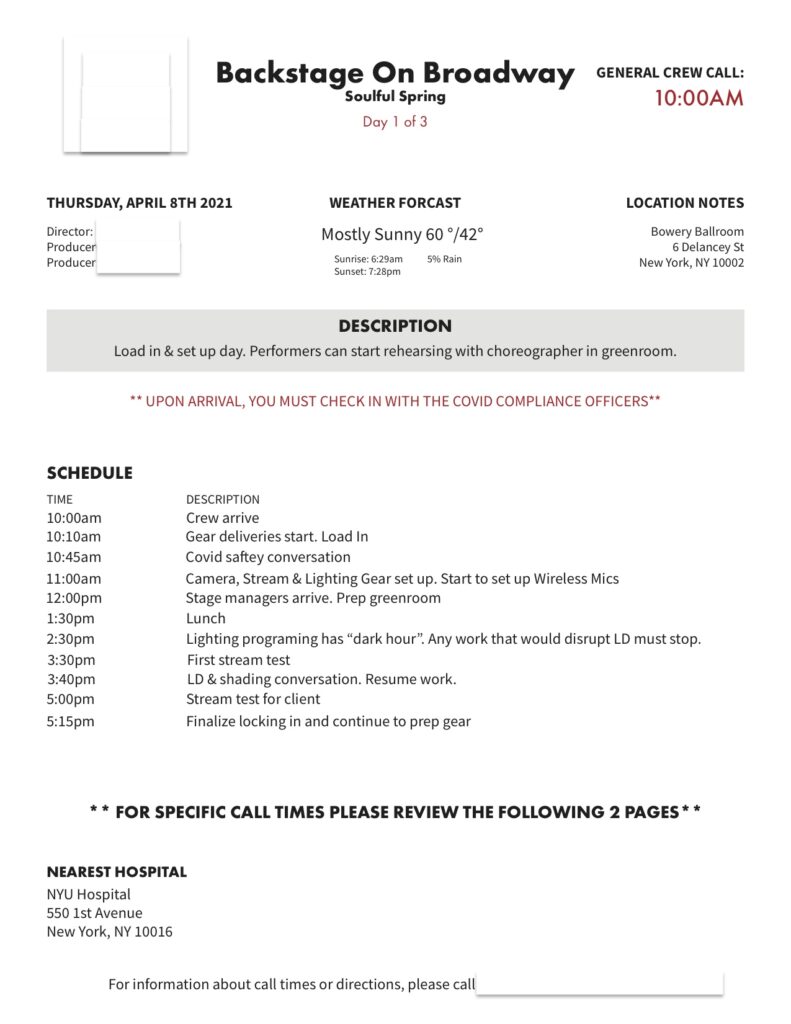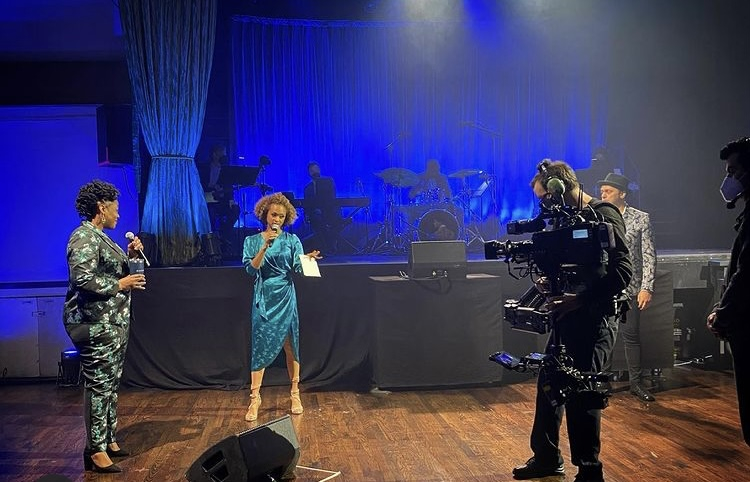Backstage On Broadway at The Bowery Ballroom
The event I want to talk you through today is another private rental. This was the venue’s first video live stream since the pandemic began. Generally, events like these are pretty rare for us. All systems are set up to enjoy a great experience in the moment. Looking ahead to the future of events, live streaming is going to be a great tool to reach a large and diverse audience, and promote accessibility to more patrons. We look forward to the future of these events and are excited to share all that we have learned from this broadcast.
To achieve the video broadcast our client was after, hi-speed Internet service is required. In our case, a separate and dedicated Internet hardline was put in by a service provider, which could be used exclusively for live streaming. The goal of this event was to broadcast approximately 60 minutes of a well-rehearsed “backstage on Broadway” experience involving show tunes sung by loveable Broadway stars. The streaming host was Chase Private Client, and this was a way for the company to give back to their customers, in lieu of the Broadway and live events shutdown.
Chase hired a team of producers to achieve their vision. The producers then work within a set budget and hire in the talent, subcontract the video, audio, and lighting, and scout the location (which is where we came in). The job of the venue was to provide a covid-safe location to film, assist with security, and supplement production needs. After the completion of the initial advance, it was determined that the house would provide power, use of our lighting rig (with a supervising LD), use of atmospherics (including our in house haze machine), use of our monitoring systems (including an engineer) and use of our front of house desk for a broadcast mix. House was also in charge of fabricating a staircase for the stage. It was clear from the start that I would be stretched thin on this event, so I put a network of systems in place to ensure all departments, including myself, could have necessary support if things were not running on time, or if any issues arose.
The producers of the event were fairly new to the world of Broadway and concert production. The more advances you go through, and the more time you spend on the job, the more you can catch the nuance, and know what questions to ask, to give you a clue as to what to expect. It was much easier for me to deal with each department and their needs separately, rather than having the producers act as a middleman. Each event is different in this way, and can also apply to tours and Tour/Production management. You do not need to know every detail of every aspect of the production/tour, but know what you need to make your job easy. PMs- have your designers/department heads type up riders, plots, and inputs/instrument lists that speak the language directly to those that need it. TMs- same thing, have all of your riders and show needs together before you hit the road. If questions come up, do not hesitate to ask the person the question is intended for. It is less important for you to know all the answers, than it is for you to know who to get the answers from.
The Covid Compliance team on-site was incredible. The testing process, a little less so. This client had our team schedule virtual testing, with testing kits that were mailed to us, and needed to be mailed back. For me, this was an easy process, but I recognized it is also problematic and prohibitive. First, all those being tested needed to have access to a personal electronic device capable of handling video conferencing, they needed to be fluent in English, have a permanent home address where they can receive mail, and needed to be able to access a UPS mailing point. I would not recommend this system unless you have pre-screened all employees and they feel comfortable to test in this way. In-person testing at a fixed location near the venue or area of work is preferred, with language assistance available. Our venue is currently working closely with Spotlight Medical to ensure fair, effective, and accessible testing for all of our staff, once we begin our own events.
The audio team was a broadcast engineer, (incredibly talented, extremely intelligent, and long lover of analog who I greatly enjoyed working with) and an RF provider with tech for all 3 days, who doubled as an A2. He was another great talent, who gave me a laugh as I watched 16 Shure RF mics go into foil containers typically used for leftovers. All in the name of Covid Compliance. House supplemented staff with a monitor engineer. In hindsight, a backline tech/stagehand would have been extremely helpful.
The lighting team was fantastic and old pals. They consisted of a designer/programmer, grip, and lighting vendor with tech for all 3 days. House supplemented with our LD, doubling as an electrical supervisor. One fixture would be hung, and the rest were ground supported on pipe and base in the balcony wings. The designer chose to use intelligent fixtures for all of his design, and stay away from our incandescent/conventional lighting. This allowed the designer to color and flicker or pulse width modulation correctly using the console.
Day One
The event slated two days of load-in, setup, and rehearsal, and 1 day for last touchups and broadcast. My biggest concern was the analog desk and outboard. I feared after 12 months of lying dormant, things would not work. At this point, my brain has forgotten about the funny little nuance of the desk. The channel with the scratchy fader I needed to replace, the auxiliary buss that behaves funny, the gate that does not gate, etc. There is such a joy of analog, of touching buttons and faders and mixing with your hands, but they require a dedicated and consistent level of maintenance and care, which you can imagine becomes difficult when you are a sweaty, smoky, packed rock club that sees a different show every night, and your responsibilities encompass more than audio. On our first day with the broadcast engineer, I was immediately put at ease. He saw the joy that I see in the desk and had the immense level of experience and knowledge to not only make it sound great but even open up and clean some faders. Prior to load in, I had managed to clean all 1800 of the knobs on the desk but ran out of time for the faders. I welcomed the assist.
Lighting and video loaded in first, audio and backline followed after that. The first day ended with setting the backline, pinning the stage, and getting the bulk of the lighting programming complete. The video team was able to get set up and a majority of their cabling was completed.
Day Two
Consisted of even more programming and our first run-through of the performance. We were given start and stop rehearsal, and a direct cue to cue which was about 75% of show ready.
Day Three
Started off with a bit of a hiccup from our end. I do my best to make sure our venue staff has all that they need to succeed at their job- resources, time, support, etc. Even still, I can forget that we have been out of practice for a year, and we are navigating new waters from the usual rock show. Our Monitor engineer, unused to theatre cue to cue style mixing and speaking on coms, found himself in the weeds. Unprepared for how to quickly and effectively use snapshots, he lost his work from the day before. The A2 and I quickly rallied in support of the monitor engineer to go through the program ahead of talent, and make sure the wedges were all dialed in, cue to cue. I am sure by the end of it our engineer became a pro at snapshots. Unfortunately, it only reinforced his lack of interest in theatrical mixing.
This was another note to myself to hire effectively and hire people who are excited by the event itself, not just the mixing aspect, or the need for a paycheck. We spoke at length about his experience afterward, and throughout it all, he handled the situation calmly and with a great attitude. The last rehearsal before the broadcast was rock solid.
Come the broadcast, I was huddled with the A1 watching a display monitor, hoping there were no streaming hiccups or issues on our end. Sure enough, the show looked beautiful and I only wish I could have heard the mix! It has been 14+ months since I listened to a mix from an engineer I love, on the Midas desk. Nonetheless, it was extremely nice to work together and talk shop, as well as share our love of motorcycles.
Loadout happened in record time, unfortunate for our dinner break which we worked right past but grateful for a sigh of relief that everyone made it out of the building safe and sound, after a great few days of work. We started on stage- breaking down backline, audio, and lighting, before moving to the balcony and front of house. This schedule gave the video and communications team a chance to organize and break down and left space for us to finish our loadout without interruption or breaking compliance.
As of now, we are still taking it easy at Bowery, and remaining cautious to reopen. It is not yet beneficial to us, or to the health of our patrons to open just yet. We are going to continue to focus on some important upgrades, study the data, and figure out a way to make artists, staff and patrons safe and excited to come back to music again. I cannot wait to share all of our new projects with you, so keep tuning in, and stay safe!
More Resources
My Take on Line-By-Line Mixing for Theatre



